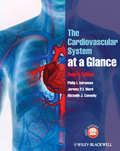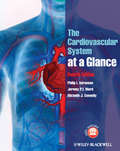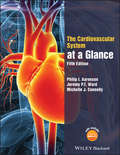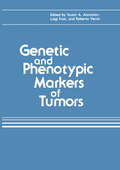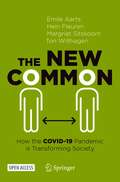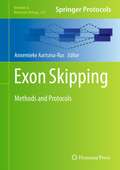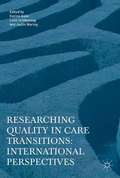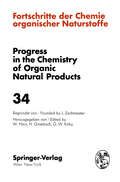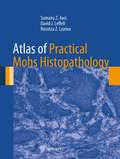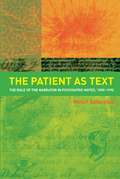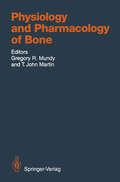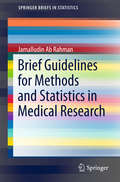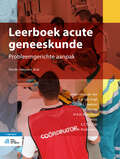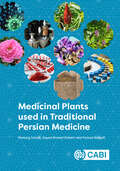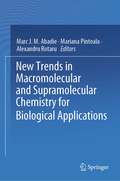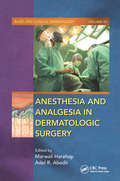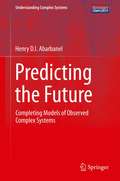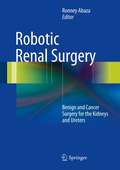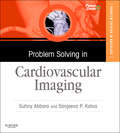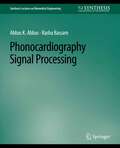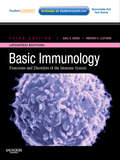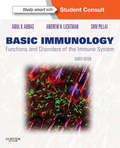- Table View
- List View
The Cardiovascular System at a Glance (At a Glance)
by Philip I. Aaronson Jeremy P. Ward Michelle J. ConnollyThis concise and accessible text provides an integrated overview of the cardiovascular system - considering the basic sciences which underpin the system and applying this knowledge to clinical practice and therapeutics. A general introduction to the cardiovascular system is followed by chapters on key topics such as anatomy and histology, blood and body fluids, biochemistry, excitation-contraction coupling, form and function, integration and regulation, pathology and therapeutics, clinical examination and investigation - all supported by clinical cases for self-assessment. Highly visual colour illustrations complement the text and consolidate learning.The Cardiovascular System at a Glance is the perfect introduction and revision aid to understanding the heart and circulation and now also features: An additional chapter on pulmonary hypertension Even more simplified illustrations to aid easier understanding Reorganized and revised chapters for greater clarity Brand new and updated clinical case studies illustrating clinical relevance and for self-assessment The fourth edition of The Cardiovascular System at a Glance is an ideal resource for medical students, whilst students of other health professions and specialist cardiology nurses will also find it invaluable. Examination candidates who need an authoritative, concise, and clinically relevant guide to the cardiovascular system will find it extremely useful.A companion website featuring cases from this and previous editions, along with additional summary revision aids, is available at www.ataglanceseries.com/cardiovascular.
The Cardiovascular System at a Glance (At a Glance)
by Philip I. Aaronson Jeremy P. Ward Michelle J. ConnollyThis concise and accessible text provides an integrated overview of the cardiovascular system - considering the basic sciences which underpin the system and applying this knowledge to clinical practice and therapeutics. A general introduction to the cardiovascular system is followed by chapters on key topics such as anatomy and histology, blood and body fluids, biochemistry, excitation-contraction coupling, form and function, integration and regulation, pathology and therapeutics, clinical examination and investigation - all supported by clinical cases for self-assessment. Highly visual colour illustrations complement the text and consolidate learning.The Cardiovascular System at a Glance is the perfect introduction and revision aid to understanding the heart and circulation and now also features: An additional chapter on pulmonary hypertension Even more simplified illustrations to aid easier understanding Reorganized and revised chapters for greater clarity Brand new and updated clinical case studies illustrating clinical relevance and for self-assessment The fourth edition of The Cardiovascular System at a Glance is an ideal resource for medical students, whilst students of other health professions and specialist cardiology nurses will also find it invaluable. Examination candidates who need an authoritative, concise, and clinically relevant guide to the cardiovascular system will find it extremely useful.A companion website featuring cases from this and previous editions, along with additional summary revision aids, is available at www.ataglanceseries.com/cardiovascular.
The Cardiovascular System at a Glance (At a Glance)
by Philip I. Aaronson Jeremy P. Ward Michelle J. ConnollyEverything you need to know about the cardiovascular system... at a Glance! The Cardiovascular System at a Glance is the essential reference guide to understanding all things circulatory. Concise, accessible, and highly illustrated, this latest edition presents an integrated overview of the subject, from the basics through to application. Featuring brand new content on stroke, examination and imaging, heart block and ECGs, and myopathies and channelopathies, The Cardiovascular System at a Glance goes one step further and offers new and updated clinical case studies and multiple-choice questions on a supplementary website. Integrates basic science and clinical topics Offers bite-size chapters that make topics easy to digest Includes coverage of anatomy and histology, blood and haemostasis, cellular physiology, form and function, regulation and integration of cardiovascular function, history, examination and investigations, pathology and therapeutics Filled with highly visual, colour illustrations that enhance the text and help reinforce learning The fifth edition of The Cardiovascular System at a Glance is an ideal resource for medical students, junior doctors, students of other health professions, and specialist cardiology nurses.
The Cardiovascular System at a Glance (At a Glance)
by Philip I. Aaronson Jeremy P. Ward Michelle J. ConnollyEverything you need to know about the cardiovascular system... at a Glance! The Cardiovascular System at a Glance is the essential reference guide to understanding all things circulatory. Concise, accessible, and highly illustrated, this latest edition presents an integrated overview of the subject, from the basics through to application. Featuring brand new content on stroke, examination and imaging, heart block and ECGs, and myopathies and channelopathies, The Cardiovascular System at a Glance goes one step further and offers new and updated clinical case studies and multiple-choice questions on a supplementary website. Integrates basic science and clinical topics Offers bite-size chapters that make topics easy to digest Includes coverage of anatomy and histology, blood and haemostasis, cellular physiology, form and function, regulation and integration of cardiovascular function, history, examination and investigations, pathology and therapeutics Filled with highly visual, colour illustrations that enhance the text and help reinforce learning The fifth edition of The Cardiovascular System at a Glance is an ideal resource for medical students, junior doctors, students of other health professions, and specialist cardiology nurses.
Genetic and Phenotypic Markers of Tumors
by Stuart A. AaronsonThe study of tumor markers is not only one of the most important but also one that offers one of the richest perspectives in biology and clinical oncology. The aim of scientists in this field is to adduce evidence of a property that is typical of and exclusive to tumor cells, and which is easy to determine, in order to immediately recognize, or even better, to foresee, neoplastic transformations. Unfortunately, despite the large number of scientists and laboratories engaged in this work, the ideal tumor marker has not yet been identified. However, it is worth noting that new trends in molecular biology and immunovirology have recently opened up new avenues that may lead to the eventual resolution of this problem. In this book, different approaches to the identification of tumor markers, from the points of view of biochemistry, immunology, and molecular biology, are compared in order to explore possible interrelationships and to stimulate scientific collaboration among scientists active in these fields, both in basic research and in clinical applications. We wish to thank all the contributors and also the publisher, especially Dr. Robert Andrews, for making the publication of this book possible.
The New Common: How the COVID-19 Pandemic is Transforming Society
by Emile Aarts Hein Fleuren Margriet Sitskoorn Ton WilthagenThis open access book presents the scientific views of some fifty experts on how they believe the COVID-19 pandemic is currently affecting society, and how it will continue to do so in the years to come. Using the concept of a “common” (in the sense of common values, common places, common goods, and common sense), they elaborate on the transition from an Old Common to a New Common. In carefully crafted chapters, the authors address expected shifts in major fields like health, education, finance, business, work, and citizenship, applying concepts from law, psychology, economics, sociology, religious studies, and computer science to do so. Many of the authors anticipate an acceleration of the digital transformation in the forthcoming years, but at the same time, they argue that a successful shift to a new common can only be achieved by re-evaluating life on our planet, strengthening resilience at an individual level, and assuming more responsibility at a societal level.
Exon Skipping: Methods and Protocols (Methods in Molecular Biology #867)
by Annemieke Aartsma-Rus“Next generation” sequencing techniques allow for more detailed analysis of exons and introns in multiple genes at the same time. This will reveal many mutations that potentially lead to exon skipping. To functionally test these a lot can be achieved with a limited set of protocols, while for the intentional induction of exon skipping different tools and target genes are involved and the translational path from in vitro splicing to in vivo tests in animal models requiring a more extensive set of protocols. Exon Skipping: Methods and Protocols provides scientist with a comprehensive guide to many of the methods and techniques used for exon skipping, such as methods on how to discriminate “real polymorphisms” from mutations that affect splicing. Written in the highly successful Methods in Molecular Biology™ series format, chapters include introductions to their respective topics, lists of the necessary materials and reagents, step-by-step, readily reproducible laboratory protocols, and key tips on troubleshooting and avoiding known pitfalls.Authoritative and practical Exon Skipping: Methods and Protocols seeks to aid scientists in the continuing study of exon skipping.
Researching Quality in Care Transitions: International Perspectives
by Karina Aase Justin Waring Lene SchibevaagThis book is concerned with the complexities of achieving quality in care transitions. The organization and accomplishment of high quality care transitions relies upon the coordination of multiple professionals, working within and across multiple care processes, settings and organizations, each with their own distinct ways of working, profile of resources, and modes of organizing. In short, care transitions might easily be regarded as complex activities that take place within complex systems, which can make accomplishing high quality care challenging. As a subject of enquiry, care transitions are approached from many research, improvement and policy perspectives: from group psychology and human factors to social and political theory; from applied process re-engineering projects to exploratory ethnographic studies; from large-scale policy innovations to local improvements initiatives. This collection will provide a unique cross-disciplinary and multi-level analysis, where each chapter presents a particular depth of insight and analysis, and together offer a holistic and detail understand of care transitions.
Researching Quality in Care Transitions: International Perspectives
by Karina Aase Justin Waring Lene SchibevaagThis book is concerned with the complexities of achieving quality in care transitions. The organization and accomplishment of high quality care transitions relies upon the coordination of multiple professionals, working within and across multiple care processes, settings and organizations, each with their own distinct ways of working, profile of resources, and modes of organizing. In short, care transitions might easily be regarded as complex activities that take place within complex systems, which can make accomplishing high quality care challenging. As a subject of enquiry, care transitions are approached from many research, improvement and policy perspectives: from group psychology and human factors to social and political theory; from applied process re-engineering projects to exploratory ethnographic studies; from large-scale policy innovations to local improvements initiatives. This collection will provide a unique cross-disciplinary and multi-level analysis, where each chapter presents a particular depth of insight and analysis, and together offer a holistic and detail understand of care transitions.
Fortschritte der Chemie Organischer Naturstoffe / Progress in the Chemistry of Organic Natural Products (Fortschritte der Chemie organischer Naturstoffe Progress in the Chemistry of Organic Natural Products #34)
by A. J. Aasen D. P. Chakraborty C. R. Enzell D. Gross J. Jacob K. H. Overton D. J. Picken A. R. Pinder W. Voelter I. WahlbergAtlas of Practical Mohs Histopathology
by Sumaira Z. Aasi David J. Leffell Rossitza Z. LazovaMohs surgery is microscopically controlled surgery used to treat common types of skin cancer and allows for the removal of a skin cancer with a very narrow surgical margin and a high cure rate. However, for those involved with the Mohs procedure, it is critical to understand the optimal preparation and interpretation of frozen sections.Complete with hundreds of high resolution figures, Atlas of Practical Mohs Histopathology is written by leading experts in the field and discusses everything from normal skin histology and rare tumors to pitfalls and incidental findings. Dermatologic surgeons, Mohs cutaneous surgeons, dermatopathologists and pathologists alike will find this book to be a comprehensive and indispensable reference.
The Patient as Text: the Role of the Narrator in Psychiatric Notes, 1890-1990
by Petter AaslestadA commonly-held model of the doctor-patient relationship casts it as a subject/object relationship: broadly the patient is a 'text', and the doctor the reader or interpreter of that text. However, recent critical models preset notions of text and reader as complex and unstable, and the relationship of doctor and patient as similarly complicated. Explorations of psychiatry and 'madness' by critics such as Michel Foucault present a further background of complex ideological change. In The Patient as Text, Petter Aaslestad explores selections from over a century of psychiatric notes from Gaustad Hospital, Norway against this critical background, exploring the impact of ideological and medical changes surrounding the psychiatric clinical relationship and psychiatric professionals as constructors of narratives. This book will be of interest to researchers in the medical humanities, psychiatric practitioners, and those with an interest in medical history and critical theory.
The Patient as Text: the Role of the Narrator in Psychiatric Notes, 1890-1990 (Radcliffe Ser.)
by Petter AaslestadA commonly-held model of the doctor-patient relationship casts it as a subject/object relationship: broadly the patient is a 'text', and the doctor the reader or interpreter of that text. However, recent critical models preset notions of text and reader as complex and unstable, and the relationship of doctor and patient as similarly complicated. Explorations of psychiatry and 'madness' by critics such as Michel Foucault present a further background of complex ideological change. In The Patient as Text, Petter Aaslestad explores selections from over a century of psychiatric notes from Gaustad Hospital, Norway against this critical background, exploring the impact of ideological and medical changes surrounding the psychiatric clinical relationship and psychiatric professionals as constructors of narratives. This book will be of interest to researchers in the medical humanities, psychiatric practitioners, and those with an interest in medical history and critical theory.
Physiology and Pharmacology of Bone (Handbook of Experimental Pharmacology #107)
by A.-B. Abou-Samra D. C. Anderson H. C. Anderson R. Baron W. Born F. R. Bringhurst E. Canalis M. Centrella M. Chakraborty D. Chatterjee P. D. Delmas J. A. Eisman E. F. Eriksen D. M. Findlay J. A. Fischer H. Fleisch J. K. Heath W. Horne H. Jüppner M. Kassem H. M. Kronenberg L. E. Lanyon A. Lomri L. Malaval T. J. Martin T. L. McCarthy F. Melsen D. C. Morris L. Mosekilde G. R. Mundy K. W. Ng S. Nussbaum A. M. Parfitt M. Peacock J.T.Jr. Potts L. G. Raisz J. H. Ravesloot V. Rosen G. Segre K. C. Shoukri A. Vesterby J. M. WozneyThe authors, all accomplished and world-renowned experts in their topic areas, have provided controversial and up-to-date accounts of the current status of research in calcium and bone metabolism by reviewing major areas of basic science which have an impact on the understanding of bone diseases and related disorders.
Brief Guidelines for Methods and Statistics in Medical Research (SpringerBriefs in Statistics #0)
by Jamalludin Bin Ab RahmanThis book serves as a practical guide to methods and statistics in medical research. It includes step-by-step instructions on using SPSS software for statistical analysis, as well as relevant examples to help those readers who are new to research in health and medical fields. Simple texts and diagrams are provided to help explain the concepts covered, and print screens for the statistical steps and the SPSS outputs are provided, together with interpretations and examples of how to report on findings. Brief Guidelines for Methods and Statistics in Medical Research offers a valuable quick reference guide for healthcare students and practitioners conducting research in health related fields, written in an accessible style.
Leerboek acute geneeskunde: Probleemgerichte aanpak
by A.B. van Vugt M. I. Gaakeer W. Henny H.A.H. Kaasjager C. Motz E.C.T.H. Tan Th. W. WulterkensIn Nederland is het vakgebied van de Spoedeisende Geneeskunde een erkend specialisme. In 2008 is het beroep SpoedEisende Hulp arts (SEH-arts) een begrip geworden. Maar binnen het curriculum geneeskunde verdient de acute geneeskunde meer aandacht. Om die reden is het Leerboek acute geneeskunde geschreven. Het resultaat is een praktisch bruikbaar studieboek, waarin acute geneeskunde op een gestructureerde manier wordt aangeboden aan de student.In Leerboek acute geneeskunde wordt de symptoomgerichte eerste benadering van de acute patiënt naar internationale standaard uiteengezet. Zo wordt de medisch student bekend gemaakt met een aanpak waarin anamnese, diagnostiek en aanvullend onderzoek in hoog tempo worden afgehandeld. Daarnaast is er volop aandacht voor de acute behandeling in geval van (potentiële) levensbedreiging. Aan de orde komen niet alleen de theoretische achtergrondkennis maar ook de praktische vaardigheden die noodzakelijk zijn voor de eerste opvang van de acute patiënt. De opvang en behandeling van de acute patiënt is bij uitstek teamwork, waarbij de inbreng van ieder teamlid van belang is, ongeacht functie, vaardigheid en ervaring. Het belang van crew-resource-management (CRM) is niet te onderschatten.Dit boek is bedoeld voor de medisch student in zowel Bachelor als Masterfase van de studie, maar ook voor verpleegkundig specialisten en physician assistants binnen de acute zorg, zoals in de ambulancezorg, afdelingen SpoedEisende Hulp (SEH) en Intensive Care. Het boek zal ook zijn nut bewijzen voor assistenten in opleiding (AIO) van poortspecialismen, evenals huisartsen, zeker binnen de diensten op een Huisartsen Post (HAP), SEH-artsen en gecertificeerde poortspecialisten.
Medicinal Plants used in Traditional Persian Medicine
by Mamak Hashemi Abadi Maryam Akabery Seyyed Ahmad Askari Sayyedeh Fatemeh Askari Zahra Ayati Sajad Azad Parmis Badr Hamed Baharara Zahra Boghrati Mina Borhani Fatemeh Etemadpour Seyed Majid Ghazanfari Shakila Hajizadeh Bahia Namavar Jahromi Lida Jarahi Mohammad Reza Kanani Seyedeh Mahnaz Karimi Abdolali Mohagheghzadeh Leila Mohtashami Ghazaleh Mosleh Nayebzadeh Motahare Maryam Nikoosokhan Roja Rahimi Zahra Taghipour Mojgan Tansaz Meysam Zaeri Elaheh Zibaee Roodabeh Bahramsoltani Amir Hossein AbdolghaffariMedicinal plants and the natural products within them, still remain the starting point for breakthroughs in the development of safe, pharmacologically active synthetic molecules for use in a wide variety of clinical situations. Traditional Persian Medicine (TPM) is one of the most ancient medical doctrines, and is well-documented in terms of information about diseases, diagnoses and treatments, especially in the application of medicinal plants. TPM has been used for centuries worldwide, and many of these methods are still used in Iran today. The book introduces the basics of TPM, and describes the key medicinal plants used for the treatment of different diseases. It also highlights possible new targets for research activities in drug discovery of natural products. The book is richly illustrated with historic drawings from old Persian pharmacopoeia and photos of plants in their natural habitats. Reference to Ayurvedic, Traditional Chinese Medicine and monastic medicine in Europe are also made. While knowledge about medicinal plants used in TPM still exists in Iran there is a risk that the detailed expertise provided by older generations will be lost in the near future. It is therefore very important that this cultural heritage is properly preserved. This book provides a valuable, evidence-based resource on TPM for researchers, practitioners and students in medicinal plants, ethnobotany and herbal medicine.
New Trends in Macromolecular and Supramolecular Chemistry for Biological Applications
by Marc J. M. Abadie Mariana Pinteala Alexandru RotaruThis contributed volume applies the insights of supramolecular chemistry to biomedical applications such as ions/water transport through nano-scale channels, gene therapy, tissue engineering and drug delivery, to cite some of the major investigations.The challenge is to understand the mechanisms of transport through tissues particularly in the therapeutic treatment of a disease where the active drug must be delivered directly to diseased cells without affecting healthy cells. As a result, smaller quantities of active substances can be used to treat the disease. Another interest concerns new ways to administer gene therapy. If genes are often delivered to their target cells by adapted viruses, the supramolecular non-viral ‘vectors’ using dynamic nano-frameworks and nano-structures are presented. In addition, it is important to reconstruct damaged tissues by mimicking natural processes in cells and polymers, such as tissue engineering and self-healing. Different options are here discussed: e.g. hydrogels based on chitosan, a carbohydrate polymer, are proving especially promising for tissue engineering and drug delivery. For controlled delivery of drugs or other biologically active compounds, hydrogels sensitive to the most important stimuli in the human body, such as temperature, pH, ionic strength, glucose and biomolecules released by the organism in pathological conditions have been developed. Finally, to assist and validate the experimental studies, computer modelling and simulations of large-sized molecular structures and systems using different molecular dynamics and quantum mechanical techniques are developed based on the experimental and chemistry synthesis.This book is of great interest for graduate students, researchers and health professionals interested in acquiring a better understanding of the mechanisms of medical treatments. In addition, it provides numerous tools to develop better therapies for human diseases.
Anesthesia and Analgesia in Dermatologic Surgery
by Adel R. Abadir Marwalli HarahapWith malpractice insurance premiums on the rise, and insurance rates for the practicing anesthesiologist at an all time high, it is important, now more than ever, to have a single source reference related to both anesthesia and analgesia and how they both relate to dermatologic surgery. This book provides comprehensive coverage on the therapeutic u
Predicting the Future: Completing Models of Observed Complex Systems (Understanding Complex Systems)
by Henry AbarbanelThrough the development of an exact path integral for use in transferring information from observations to a model of the observed system, the author provides a general framework for the discussion of model building and evaluation across disciplines. Through many illustrative examples drawn from models in neuroscience, geosciences, and nonlinear electrical circuits, the concepts are exemplified in detail. Practical numerical methods for approximate evaluations of the path integral are explored, and their use in designing experiments and determining a model’s consistency with observations is explored.
Robotic Renal Surgery: Benign and Cancer Surgery for the Kidneys and Ureters
by Ronney AbazaRobotic Renal Surgery: Benign and Cancer Surgery for the Kidneys and Ureters provides a comprehensive review of the role of and technical considerations regarding robotic surgery for conditions of the kidney and associated conditions of the upper urinary tract. In addition to serving as a reference regarding indications, preoperative and postoperative management, complications, and evidence-based outcomes, this text also serves as a practical guide for surgeons in how to perform the complete array of robotic kidney and upper tract surgery. Included are detailed descriptions of positioning, instrumentation, and surgical steps for the surgeon newly adopting robotic surgery or for those refining their techniques. All chapters are written by recognized and published experts in the various techniques, creating an authoritative text on the subject. Robotic Renal Surgery: Benign and Cancer Surgery for the Kidneys and Ureters will be of great value to urologists, robotic surgeons, fellows in urologic oncology or endourology as well as urology residents in training and surgical nurses and other surgery team members involved in these procedures.
Problem Solving in Radiology: Cardiovascular Imaging E-Book
by Suhny Abbara Sanjeeva P KalvaOptimize diagnostic accuracy with Cardiovascular Imaging, a title in the popular Problem Solving in Radiology series. Drs. Suhny Abbara and Sanjeeva Kalva use a problem-based approach to help you make optimal use of the latest cardiovascular imaging techniques and achieve confident diagnoses. Consult this title on your favorite e-reader with intuitive search tools and adjustable font sizes. Elsevier eBooks provide instant portable access to your entire library, no matter what device you're using or where you're located.Make the most effective use of today's imaging techniques, including PET and SPECT.Perform effective interventions using the newest grafts, stents, and coils.See conditions as they appear in practice with more than 2,350 images detailing anatomy, normal anatomic variants, and pathology.Make optimal clinical choices and avoid complications with expert protocols and tricks of the trade.Avoid common problems that can lead to an incorrect diagnosis. Tables and boxes with tips, pitfalls, and other teaching points show you what to look for, while problem-solving advice helps you make sound clinical decisions. Quickly find the information you need thanks to a well-organized, user-friendly format with consistent headings, detailed illustrations, and at-a-glance tables.
Phonocardiography Signal Processing (Synthesis Lectures on Biomedical Engineering)
by Abbas K. Abbas Rasha BassamThe auscultation method is an important diagnostic indicator for hemodynamic anomalies. Heart sound classification and analysis play an important role in the auscultative diagnosis. The term phonocardiography refers to the tracing technique of heart sounds and the recording of cardiac acoustics vibration by means of a microphone-transducer. Therefore, understanding the nature and source of this signal is important to give us a tendency for developing a competent tool for further analysis and processing, in order to enhance and optimize cardiac clinical diagnostic approach. This book gives the reader an inclusive view of the main aspects in phonocardiography signal processing. Table of Contents: Introduction to Phonocardiography Signal Processing / Phonocardiography Acoustics Measurement / PCG Signal Processing Framework / Phonocardiography Wavelets Analysis / Phonocardiography Spectral Analysis / PCG Pattern Classification / Special Application of Phonocardiography / Phonocardiography Acoustic Imaging and Mapping
Basic Immunology Updated Edition E-Book: Functions and Disorders of the Immune System
by Abul K. Abbas Andrew H. LichtmanThis updated 3rd edition of Basic Immunology provides a readable and concise introduction to the workings of the human immune system, with emphasis on clinical relevance. The format makes learning easy with short, easy-to-read chapters, color tables, key point summaries, and review questions in every chapter. You’ll get the latest coverage on regulatory T cells, biology of the Th17 subset of CD4+ T cells, and more. The full-color artwork, comprehensive glossary, and clinical cases are just some of the features that reinforce and test your understanding of how the immune system functions.Covers the most up-to-date immunology information including regulatory T cells, and biology of the Th17 subset of CD4+ T cells to keep you completely current. Relates basic science to clinical disorders through clinical cases for better application in a real-world setting. Provides a full Glossary to keep you on the cutting edge of immunologic terminology. Includes appendices summarizing the features of CD Molecules, a handy Glossary, and Clinical Cases that test your understanding of how the immune system functions in health and disease. Presents beautiful full-color artwork for enhanced visual learning.
Basic Immunology E-Book: Functions and Disorders of the Immune System
by Abul K. Abbas Andrew H. Lichtman Shiv PillaiUnderstand all the essential concepts in immunology with Basic Immunology: Functions and Disorders of the Immune System! This concise, focused text provides you with an up-to-date, accessible introduction to the workings of the human immune system. Efficiently master the immunology information you need through clinically focused content, logically organized by mechanism. Apply what you've learned to real-world situations by referencing the appendix of clinical cases. Enhance your learning with the help of numerous full-color illustrations and useful tables, as well as summary boxes, review questions, and a glossary of immunology terms.Study immunology anywhere! Online access to www.StudentConsult.com opens the door to an enhanced e-book and ancillary components!Visualize complex immunology concepts with a completely updated art program.Test your knowledge. New PowerPoint Review slides added to www.StudentConsult.com are ideal for study sessions.
